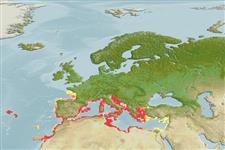Common names from other countries
Environment: milieu / climate zone / depth range / distribution range
Ecologia
; intervalo de profundidade 1 - 100 m (Ref. 105991). Subtropical; 49°N - 27°N, 19°W - 36°E
Eastern Atlantic and Mediterranean: from France to Spain, Portugal, Morocco, Madeira Island and Canary Islands, including the Mediterranean.
Length at first maturity / Tamanho / Peso / Idade
Maturity: Lm ? range ? - ? cm Max length : 8.3 cm SHL macho/indeterminado; (Ref. 123052); Peso máx. publicado: 58.20 g (Ref. 123052)
Intertidal to a depth of 80 m. Found in a lagoon (Ref. 105976). Also found offshore (Ref. 122927). Inhabits rocky, sandy-mud and mud substrata (Ref. 105992). Also found on seagrass (Ref. 85545). Opportunistic feeder, exhibiting both carnivory and scavenging. Feeds on a variety of bivalves, including gastropods, barnacles, tunicates, bryozoans, carrion and its conspecifics. Employs drilling and chipping patterns on certain bivalves (Ref. 106099).
Life cycle and mating behavior
Maturidade | Reprodução | Desova | Ovos | Fecundidade | Larvas
This species is a non-broadcast spawner. Life cycle does not include trocophore stage. Also Ref. 833.
Templado, J. and R. Villanueva. 2010. (Ref. 85339)
Status na Lista Vermelha da IUCN (Ref. 130435)
Status no CITES (Ref. 108899)
Not Evaluated
Not Evaluated
Perigo para os humanos
Harmless
Uso pelos humanos
Pescarias: espécies comerciais
| FishSource |
Ferramentas
Mais informação
Idade/TamanhoCrescimentoComprimento-pesoComprimento-comprimentoMorfologiaLarvasAbundância
Fontes da internet
Estimates based on models
Preferred temperature
(Ref.
115969): 14.5 - 21.5, mean 18.7 (based on 202 cells).
